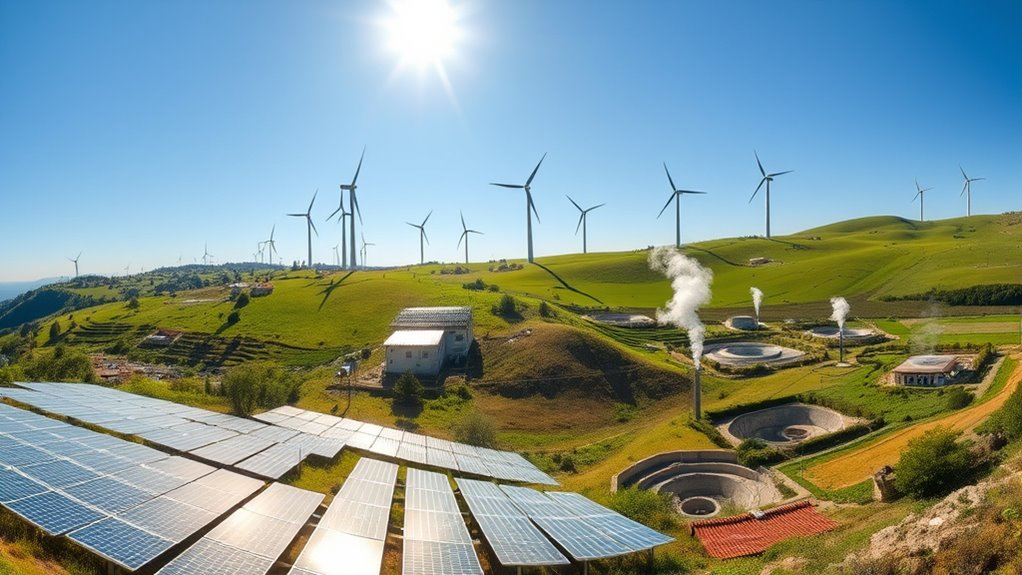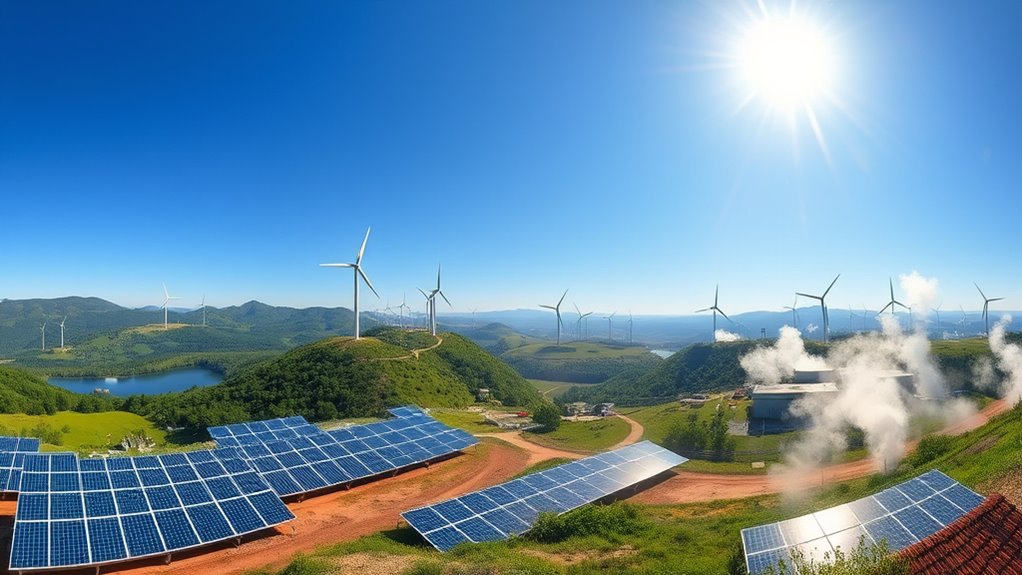Italy is making impressive progress in renewable energy, focusing on solar, wind, and geothermal power. You can see their efforts to harness natural resources and meet ambitious targets by 2030. Policies like tax credits and subsidies help push this progression ahead, supported by EU funds and technological innovations. Advances in energy storage also improve grid stability, making renewables more reliable. Stay with us to discover how Italy’s green energy journey continues to unfold.
Key Takeaways
- Italy has made significant progress in solar, wind, and geothermal energy, aiming for high renewable contribution by 2030.
- Geographic advantages like abundant sunlight and coastline support extensive solar and wind energy development.
- Policy incentives such as tax credits and subsidies encourage investment in renewable projects.
- Energy storage technologies improve grid stability by managing renewable energy intermittency.
- EU policies and technological advancements bolster Italy’s leadership in sustainable renewable energy growth.

Are you curious about Italy’s progress in renewable energy? The country has made significant strides, especially in harnessing solar, wind, and geothermal power. As Italy pushes toward its climate goals, understanding how it manages these resources is essential. One key factor in this transition is energy storage. Italy recognizes that renewable energy production can be intermittent, so investing in energy storage solutions is indispensable. Battery systems and other storage technologies allow excess solar and wind energy to be saved for times when production dips, ensuring a steady supply. This not only stabilizes the grid but also makes renewable sources more reliable and attractive for investors. Policy incentives play a central role in fostering this development. The government has introduced various measures, such as tax credits, subsidies, and streamlined permitting processes, to encourage both large-scale projects and individual solar installations. These incentives lower entry barriers, making renewable investments more appealing and financially viable for businesses and households alike. By creating a favorable policy environment, Italy stimulates innovation and accelerates the adoption of renewable energy technologies. The country’s commitment is also reflected in its ambitious targets—aiming to produce a significant portion of its energy from renewables by 2030. Such goals motivate further policy support and investment in energy storage solutions, which are essential to manage the variable nature of solar and wind power. Italy’s geographic advantages, like abundant sunlight and a long coastline, provide ideal conditions for solar and wind farms, and these resources are increasingly integrated into national energy plans. The government’s focus on policy incentives helps guarantee that these resources are harnessed efficiently and sustainably. Furthermore, Italy’s renewable energy sector benefits from European Union directives that promote cross-border energy cooperation and funding. These policies provide additional financial backing and foster technological innovation. Additionally, advancements in energy storage technology are critical in addressing the intermittency of renewable sources. As a result, Italy is not only expanding its renewable capacity but also improving grid resilience and energy security. You can see that Italy’s approach combines technological advancements with strategic policy measures. The emphasis on energy storage ensures that renewable energy is more consistent and dependable. Meanwhile, policy incentives create a conducive environment for growth, attracting investments and encouraging widespread adoption. Together, these elements form a robust foundation for Italy’s renewable energy future, positioning the country as a leader in sustainable development. If you’re interested in Italy’s green transition, it’s clear that the combination of cutting-edge energy storage and supportive policy incentives will continue to drive progress. This integrated approach is key to overcoming challenges and guaranteeing a cleaner, more sustainable energy landscape for Italy.
Frequently Asked Questions
How Does Italy’s Renewable Energy Policy Impact Local Communities?
Your community benefits from Italy’s renewable energy policies through increased community engagement, which fosters local support and participation in projects. These policies aim to diminish environmental impact, leading to cleaner air and preserved natural landscapes. As a result, you may experience job opportunities and economic growth, while enjoying a healthier environment. Active involvement and sustainable development help guarantee that renewable energy benefits your community both economically and environmentally.
What Are Italy’s Future Targets for Renewable Energy Capacity?
Italy aims to boost its renewable capacity to 70% by 2030, setting ambitious future capacity targets aligned with its renewable goals. You’ll see the country investing heavily in solar, wind, and geothermal projects, transforming its energy landscape. This push isn’t just a pipe dream; it’s a clear roadmap to a cleaner, more sustainable future, ensuring Italy remains a leader in renewable energy on the European stage.
How Does Italy Manage Grid Integration of Renewables?
Italy manages grid integration of renewables by investing in grid stability and modern power transmission infrastructure. You’ll find that they utilize advanced grid management systems to balance supply and demand, ensuring consistent power delivery. They also incorporate energy storage solutions and interconnections with neighboring countries, which help smooth out fluctuations from renewable sources, maintaining reliable electricity flow and minimizing disruptions across the network.
What Are the Economic Benefits of Renewable Energy in Italy?
Think of Italy’s shift to renewables as planting a forest of economic growth. You benefit from job creation across manufacturing, installation, and maintenance sectors, which boosts local economies. Plus, renewable projects attract investment opportunities, fostering innovation and sustainable development. This progression reduces reliance on fossil fuels, lowering energy costs and increasing energy security. Overall, embracing renewables helps you build a resilient economy while protecting Italy’s natural beauty for future generations.
How Does Italy Support Innovation in Renewable Technologies?
Italy supports innovation in renewable technologies through funding for research collaborations and technological advancements. You’ll find government grants and incentives encouraging universities and private companies to develop cutting-edge solutions. Italy also promotes partnerships between research institutions and industry players, fostering knowledge exchange and new innovations. These efforts help you stay at the forefront of renewable technology, ensuring Italy’s energy sector continues to grow sustainably and efficiently.
Conclusion
As you witness Italy’s shift towards solar, wind, and geothermal energy, it’s clear that the country is embracing a sustainable future. If Leonardo da Vinci were alive today, he’d be sketching plans for a greener Italy, much like a modern-day Steve Jobs revolutionizing tech. By continuing this momentum, you can be part of a movement that’s transforming Italy’s landscape—and the planet—one renewable source at a time. The future’s bright, and it’s yours to shape.








